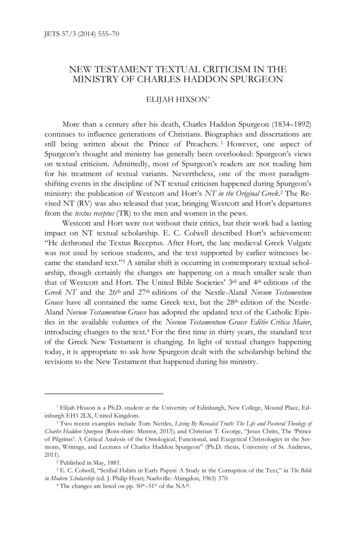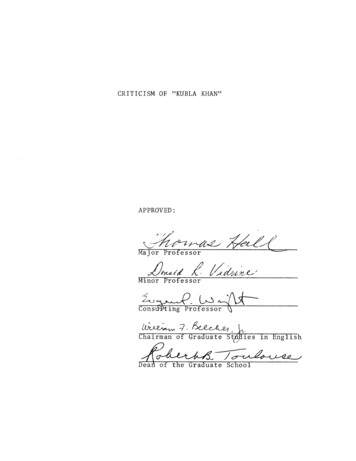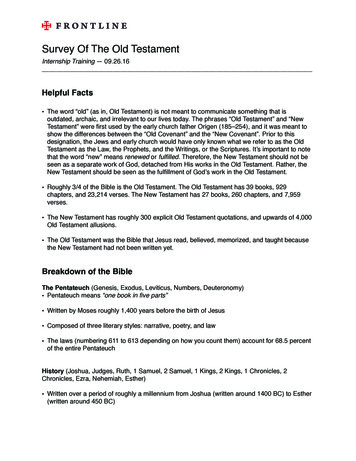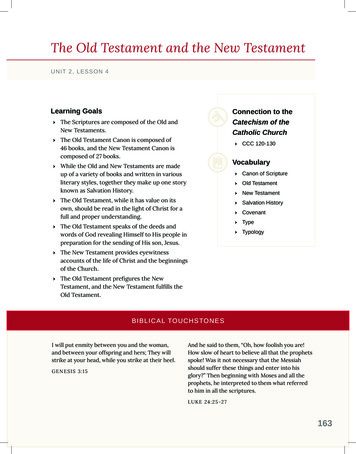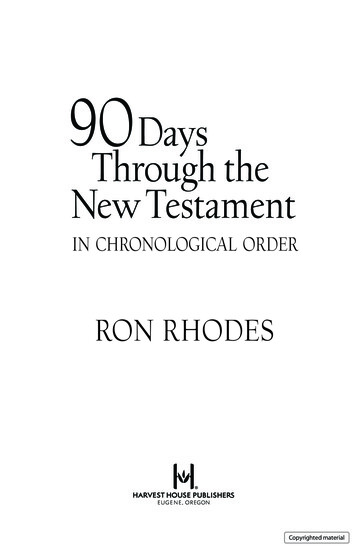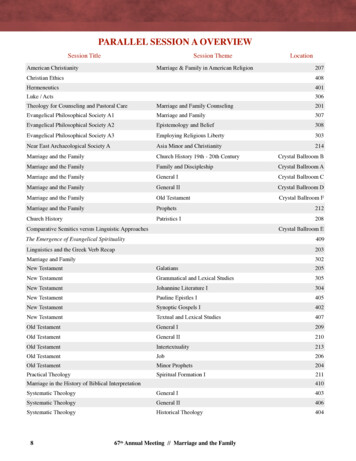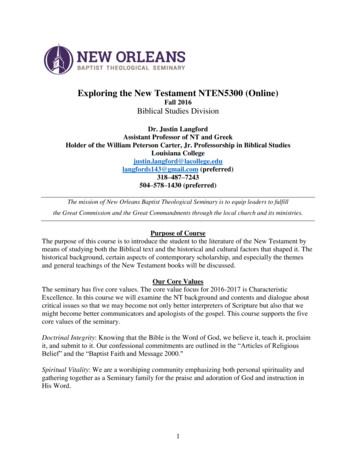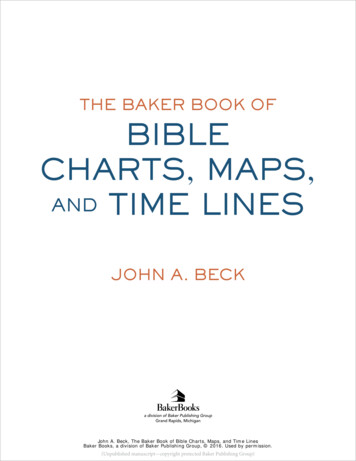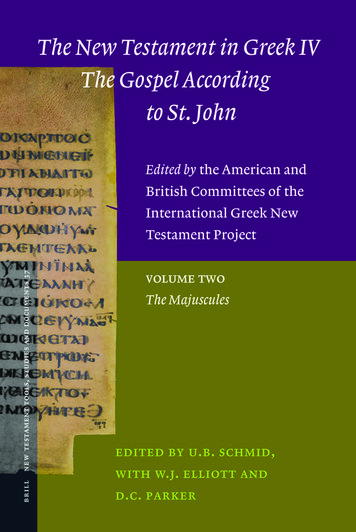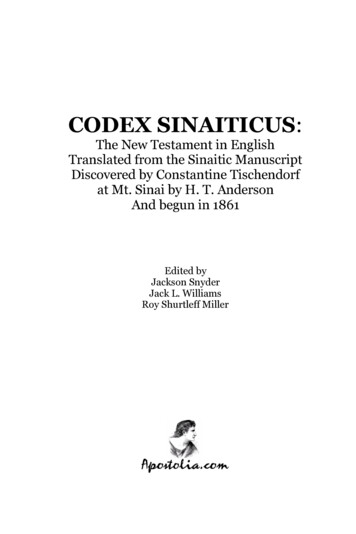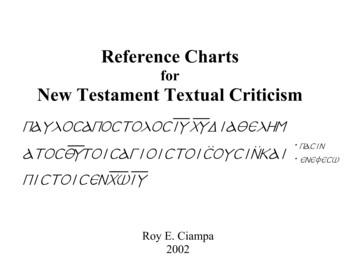
Transcription
Reference ChartsforNew Testament Textual Criticismpaulosapostolosi8u8 x8u87diaqelhm usink aiatosq8u8toisagioistoisopistoisenx88787w8i8u8Roy E. Ciampa2002: pasin:7enefesw
2003 Roy E. CiampaThese materials have been prepared for the private use of students of Gordon-Conwell Theological Seminary’s course NT502:Interpreting the New Testament, and are not to be distributed to other persons without the express written permission of theauthor.
Table of Contents1. Summary of the Alands’ Categories ------------------------ 12. Summary of Signs and Symbols employed in Nestle-Aland27 --------------------------------------------- 23. Chart of Papyri Manuscripts --------------------------------- 54. Chart of Uncial Manuscripts --------------------------------- 75. Chart of Miniscule Manuscripts cited in Nestle-Aland27 or UBS4 --------------------------------------- 157. Chart of Lectionary Manuscripts cited in Nestle-Aland27 or UBS4 -------------------------------------- 188. Chart of Ancient Versions ----------------------------------- 219. Chart of Early Church Fathers cited in Nestle-Aland27 or UBS4 ----------------------------------------- 2410. Map of Geographical Regions referred to in the ------ 3311. List of Consistently Cited Witnesses ---------------------- 3412. Contents of Greek Manuscripts ---------------------------- 4113. Charts and Guidelines for the Analysis of Textual Variants --------------------------------------------- 6114. Basic Text-Critical Chart for Ephesians ------------------ 6415. Geographical Distribution of the Witnesses to Ephesians ------------------------------------------------ 6516. Basic Text-Critical Chart for Galatians ------------------- 6617. Basic Text-Critical Chart for John ------------------------ 6718. Text-Critical Chart for John 3:12 -------------------------- 6819. Blank Text-Critical Charts ---------------------------------- 6920. ---------- 72NT book abbr.: Mt, Mk, Lk, Jn, Act, Rm, 1-2C, Gl, Eph, Ph, Cl, 1-2Th, 1-2Tm, Tt, Phm, H(eb), Jas, 1-2P, 1-3Jn, Jd, ApReference Charts for New Testament Textual Criticism / i
Introductory Notes1. The student is encouraged to prepare their own copy of the charts of the contents of the Greekpapyri and uncial manuscripts and attach their copy to the back of these reference charts.2. When manuscripts are placed in the 1st category without any further elaboration (whether theyare of the strict, better-than-normal, normal or free varieties) they should be placed in the chartas 1-n (1st category, normal) manuscripts.3. In cases where the dating or quality of manuscripts is doubtful or varying (respectively), that iswhere a manuscript is dated to the III/IV centuries or is said to be of the III-V category, it isrecommended that they be given the benefit of the doubt when placed in a chart and includedin the earliest mentioned century and the column for the highest quality suggested.4. Regarding the contents of the manuscripts (chapter 12) it should be remembered that a verse isconsidered “included” in a manuscript even if it only contains one letter of that verse.Therefore when using a list of contents to prepare a chart regarding a negative apparatus(where only the evidence for a rejected variant is provided) it is best not to include thosemanuscripts that list the verse as the first verse following a lacuna or the last verse precedingone.5. When a list of contents begins with the abbreviation “vac.” it means that the manuscript islacking the texts listed. The beginning of each list of the contents of a manuscript should beexamined to see if it is a list of the texts included in the manuscript or a list of those it lacks.Reference Charts for New Testament Textual Criticism / ii
The Categories of the Alands’ System:Category I:Manuscripts of a very special quality which are particularly important forestablishing the original text. (The Alands place the Alexandrian text in thiscategory along with the papyri and uncials through the third or fourthcentury. The papyri are usually subdivided into the subcategories of strict,better than normal, normal, or free.)Category II: Manuscripts of a special quality that are important for establishing theoriginal text but that are slightly inferior to the first category due to thepresence of some “alien influences” (e.g., the smoother, more polishedreadings that are typically found in greater numbers in the Byzantine text).Category III: Manuscripts with an independent text that are often valuable for establishingthe original text and that are frequently just as valuable for understandingthe history of the text. (Manuscripts that are not Byzantine but that reflect arelatively strong Byzantine influence or an unusually high number of specialreadings are placed in this category, This is a broad category and is the onein which I have placed most of the versions and fathers.)Category IV: Manuscripts that follow the D text (traditionally the “Western” text type).Category V: This is the category for Byzantine Manuscripts.Reference Charts for New Testament Textual Criticism / 1
Signs, Symbols and Latin Abbreviations of Nestle-Aland27@#Square brackets in the text indicate that textual critics are not entirely convinced of the authenticity of the enclosed words, but thereading given in the text reveals the preference of the editors.áâDouble brackets indicate that the enclosed words, generally of some length, are known not to be a part of the original text. Thesetexts derive from a very early stage of the tradition, and have often played a significant role in the history of the church.êè éÝä åThe word following in the text is omitted by the witnesses cited.Þâ áâ 3214ãÞ ß Þ1 Þ2This sign marks the location where one or more words, sometimes a whole verse, is inserted by the witnesses cited.@ÕA large dot followed by a bold verse number opens each new section of the apparatus. A broken vertical line separates the various alternative readings from each other within a single instance of variation.The words, clauses, or sentences contained between these signs are omitted by the witnesses cited.The word following in the text is replaced with one or more words by the witnesses cited.The words contained between these two signs are replaced with other words by the witnesses cited. Frequently this involves thetransposition of words.The words contained between these two signs are transposed by the witnesses citedThe order of the transposed words in the different variants is indicated by numerals.The word or verse of text is transposed as indicated in the apparatus.When the same sign appears more than once within the same verse they are distinguished by the presence of a raised point besidethe second appearance, (both in the text and in the apparatus) and/or by the enumeration of each usage.A solid vertical line separates the instances of variation from each other within a single instance of variation.Reference Charts for New Testament Textual Criticism / 2
%Witnesses which show only minor differences are noted in parentheses along with the witnesses for the main variant. The full27reading of these minor variations can be found in Appendix II of NA .†A cross marks a change in the text from the 25th edition, where the reading so marked stood in the text. These passages alwaysrepresent very difficult textual decisions.B*A raised asterisk identifies the original reading when a later correction/alteration was made to the manuscript.BcA raised “c” identifies a correction made by a later hand, but sometimes also by the first hand.B1 B2 B3Raised numerals identify corrections made by the first, second, or third corrector (or group of correctors). –These signs are used in place of add. [adds] and om. [omits] where such brevity is not inconsistent with clarity.(L 2,7)A parenthetical reference to a passage standing before a variant reading refers to a parallel passage in another New Testamentbook. If the parenthetical reference does not name a book the parallel is found within the same book.a. ante, beforeadd. addit/-unt, add(s)al alii: some manuscripts (more than represented by pc), other than those explicitly mentioned for a given reading which differ fromthe Majority text.bis twice; immediately following a critical sign, refers to two similar words in the text and their variant(s) which are exceptionallyidentified by the same critical sign.ex err. ex errore, erroneously, by scribal error.ex itac. ex itacismo, by itacism, the substitution of letters with the same phonetic value.ex lat? ex versione latina?: apparently derived from a Latin reading.h.t. homoioteleuton: indicates an omission due to the similar endings of successive words, phrases, or sentences (a visual error: thescribes eye skips from the first to the second, in effect omitting the text between them).id./ead. idem/eadem, the same wording.Reference Charts for New Testament Textual Criticism / 3
mg in margine: a reading in the margin of a manuscript that is not identified as either a correction or an alternative reading.ms/mss manuscript (ms) or manuscripts (mss). In the apparatus it indicates that one or more of the manuscripts of the vulgate (but not allof them) supports a particular reading.om. omittit/-unt: omit(s).p. post, afterp)Refers to parallel passages in the Gospels, which are listed in the margin at the beginning of the pericopes.pc pauci: a few manuscripts, other than those explicitly mentioned for a given reading, which differ from the Majority text.pm permulti: a large number of manuscripts, when the Majority text is divided.pon. ponit: place(s), transpose(s)rell reliqui: the rest of the manuscript tradition (including à) supporting txt; a few specially authoritative witnesses may precede rell.txt textus: as a superscript sign indicates the reading in the text of a manuscript which also records an alternative reading (coordinated with the superscript signv.l.txtis).27txtThis sign ( textus) introduces the list of witnesses supporting the text of the NA edition. It always occurs as the last member ofa group of readings, or variation unit.vac. vacat: used to identify the extent of lacunae, and is placed after a summary indication of contents (one or more of e a c p r or abook title). Note: A verse is counted as present even if only a single letter of it is preserved.vid ut videtur: indicates that the reading attested by a witness cannot be determined with absolute certainty. The signindicates a high degree of probability, usually based on some surviving letters or parts of letters.v.l. varia lectio: indicates a reading recorded in a manuscript as an alternative reading (txtv.l.vidalwaysis coordinated with the superscript sign).Reference Charts for New Testament Textual Criticism / 4
Greek ManuscriptsMsPapyri 1 2 3 4 5 6 7 8 9 10 11 12 13 14 15 16 17 18 19 20 21 IIIacppppppppreceeTrad. Text Type Aland o brief“mixed �mixed”III-f?IIII-n?I-f?III-n I-nIII-nIII-nIIII-n 23 24 25 26 27 28 29 30 31 32creppeapppIIIIVIVca. 600IIIIIIIIIIIIVIIca. 200 33aVIA“agrees w/ )”1W“agrees wA/)”A(w/W)AW?“mixed”“agrees w/)”“agrees w/) andwith F and G”A 34 35 36 37 38 39 40 41 42peeeaepaeVIIIV?VIIII/IVca. 300IIIIIIVIIIVII/VIIIA“mixed A/W”“mixed W/A”CWAAW“agrees w/A” 58I-sI“unclassifiable”II-sI-nI-fI-n II-n IIIII-sIIII-fIVlI-sI-fIIIII1In this column, the letter(s) following "agrees w(ith)/" refer to manuscriptsand not to text types.e – Gospels; a – Acts; c – Catholic Epistles; p – Pauline Epistles; r – Revelation; K – Commentary; Palim. – Palimpsest; Grk – Greek; Lat - LatinA – Alexandrian; B – Byzantine; K – Koiné (proto-Byzantine); C – “Cesarean”; W – “Western”s - strict; n - normal; n - normal or better; f – free; sis. – sister to; inf. – influenced byReference Charts for New Testament Textual Criticism / 5
43 44 45 46 47ree, aprVI/VIIVI/VIIIIIca. 200III 48 49 50 51 52 53 54apapJne, aJasIIIIIIIV/Vca. 400ca. 125IIIV/VI 55 56 57 58 59 60 61 62 63 64Jnaacf. 33JnJnpMtJnMtVI/VIIV/VIIV/VVIIca. 700ca. 700IVca. 500ca. 200 65 661ThJnIIIca. 200[ 67]AAMk-C; a-AAA (“agrees w/A,C and )”)WAA (“agrees w/B”)“mixed”Amixed Egyptian“agrees w/B, )and C”AAAAIIIII-fI-fI-nIVlI-n IIIIII-nI-n III/IIIIIIIIIIIAIII“prob. Egyptian” IIAIIII inf. VI-sA“mixed”I-s?I-f 6768 cf. 641Corca. 200VII? 69 70 71 72 73 74LkMtMt1-2P, JdMtacIIIIIIIVIII/IVVIIVII 75 76 77 78 79 80 81 82 83 84 85 86 87 88 89 90 91 92eJnMtJdHebJn1PLkMtMk, JnApMtPhmMkHebJnActsEph 1, IIIIIIII/IV“agrees w/ )”“agrees w/TRagainst Alex.”“mixed”“agrees w/B”“mixed”Egyptian“agrees w/A”A “agrees w/B”I-sIIIIVlI-sIII-n-Pet; I-f-JudVII-sIIII-n I-fIIIIIIIIIIIII (inf. V)IIIII-nIIIIII?IIIII?e – Gospels; a – Acts; c – Catholic Epistles; p – Pauline Epistles; r – Revelation; K – Commentary; Palim. – Palimpsest; Grk – Greek; Lat - LatinA – Alexandrian; B – Byzantine; K – Koiné (proto-Byzantine); C – “Cesarean”; W – “Western”s - strict; n - normal; n - normal or better; f – free; sis. – sister to; inf. – influenced byReference Charts for New Testament Textual Criticism / 6
93 94 95 96 97 98 99 100 101 102 103 104 105 106 107 108 109 110 111 112 113 114 115Jn 13Rm 6Jn 5Mt 3Lk 14Ap 1pJas 3-4Mt 3-4Mt 4Mt 13-14Mt 21Mt 27-28Jn 1Jn 17Jn 17-18Jn 21Mt 10Lk 17Acts 26-27Rm 2Heb 1ApVV/VIIIIVIVI/VIIII?ca. 400III/IVIIIIII/IVII/IIIII II?I-?III?I-?I-?III?Uncials2CategoryB/C/O/S3à)* 01eacpreacprIVBA)1 01)2 01)c 01A 02eacpreacpreacpreacprIV-VIca. VIIXIIVAAAe-B; acpr-AB* 3023/06/063/16IIIe-III-V; 1/09/080/102Manuscripts not listed here are late Byzantine manuscripts withoutindependent readings of interest.3Byzantine/Consensus/Original (UBS-Nestle/Aland)/Special readings. Thestatistics are given in the following order: Gospels, Acts, Pauline Epistles,Catholic Epistles.4Represents the majority text, the Byzantine (B) and all other consistentlycited mss of the 2nd order that agree with the majority text in any given case.e – Gospels; a – Acts; c – Catholic Epistles; p – Pauline Epistles; r – Revelation; K – Commentary; Palim. – Palimpsest; Grk – Greek; Lat - LatinA – Alexandrian; B – Byzantine; K – Koiné (proto-Byzantine); C – “Cesarean”; W – “Western”s - strict; n - normal; n - normal or better; f – free; sis. – sister to; inf. – influenced byReference Charts for New Testament Textual Criticism / 7
B1 03B2 03C* 04eacpeacpeacprcontempVI/VIIVAAAC1 04C2 04C3 04D* 05eacpreacpreacpreaccontempca. VIca. IXVAAAGrk/Lat5; WD1 05D2 05Dc 05D* 06eaceaceacpVI-VIIca. IXXIIVIWWWGrk/Lat; WD1 06D2 06Dc 06cpppca. VIIca. IXlaterWWWDabs 1Dabs 2E py of D06copy of D06V209/107/001/9E 08aVILat/GrkEpF 09peIX/XIXWF 010pIXGrk/Lat; WG 011eIXBG 012pIXGrk/Lat; WH 013eIXBH 014aIXBH 015pVIAI 016pV(Egyptian) AK 017eIXBK 018acpKIXBL 019eVIII(Egyptian) ABII036/21/022/22copy of 080/11/004/04II052/75/125/64Grk/Lat or Grk/Coptic, etc. indicates that the manuscript is a diglot.e – Gospels; a – Acts; c – Catholic Epistles; p – Pauline Epistles; r – Revelation; K – Commentary; Palim. – Palimpsest; Grk – Greek; Lat - LatinA – Alexandrian; B – Byzantine; K – Koiné (proto-Byzantine); C – “Cesarean”; W – “Western”s - strict; n - normal; n - normal or better; f – free; sis. – sister to; inf. – influenced byReference Charts for New Testament Textual Criticism / 8
L 020acpIXBM 021eIXBN 022eVIBO 023eVIBP 024eVIPalim.Lat; BP 025acprIXa-B; r-B (free)Q 026Lk, JnVPalim.Lat; BR 027LkVIPalim.Syriac; BS 028e949BVSahidic/Grk(Egyptian) AIXBT 029e 0113 . 0125 . 0139U 0a/r: V; /05/000/02V011/04/000/05V206/105/004/12IIV 031eIXBW 032eVmixedX 033eKXBY 034e†IXBZ 035MtVIAG 036eXBD 037eIXQ 038eIXGrk/Lat; B(Mk-A)CL 039Lk-JnIXBX 040LkVIPalim. l; AP 041eIXBS 01/116A: Lk 1:1-8:12; Jn 5:12-21:25; B: Mt; Lk 8:13-end; W: Mk-1:1-5:30; C:Mk 5:31-16:20; mixed addition from the 7th century: Jn 1:1-5:11.e – Gospels; a – Acts; c – Catholic Epistles; p – Pauline Epistles; r – Revelation; K – Commentary; Palim. – Palimpsest; Grk – Greek; Lat - LatinA – Alexandrian; B – Byzantine; K – Koiné (proto-Byzantine); C – “Cesarean”; W – “Western”s - strict; n - normal; n - normal or better; f – free; sis. – sister to; inf. – influenced byReference Charts for New Testament Textual Criticism / 9
F 043Mt-MkVIBY 044eacpVIII/IXmixedW 54055JnAp 11-22Ap 7-8Lk 1-2Jn 16-19eK7IXXXIXVIIIXIBBBB7V131/83/011/18III (c: ?(cf. Aland)056057058059 0215060061062apKXaMt 18Mk 15IV/VIVIV/VJn 141Tm 3-6Gl 4-5VIVVBunique readingsPalim. 03/08IIII?IIIIIIVIIIB063Lk 16-Jn 6IXV 0117064Mt-MkVIPalim. Syriac; B V 074 . 090065Jn 11-16VIPalim. Georgic; B V066Acts 28VIPalim. Georgic III067Mt 14,Mk 9VIPalim. Georgic III (inf. V)068Jn 13, 16VPalim. SyriacIII069Mk 10, 11VIII070Lk-JnVIGrk/CopticIII 0110 . 0124 . 0178 . 0179 . 0180 . 0190 . 0191 . 0193 . 0202071Mt 1, 2V/VIII072Mk 2, 3V/VIPalim. Arabic III073Mt 14VIII 084074cf. 064VIPalim. Syriac; B VA: Mk, apc and partly in Lk & Jn; B:Lk, Jn.e – Gospels; a – Acts; c – Catholic Epistles; p – Pauline Epistles; r – Revelation; K – Commentary; Palim. – Palimpsest; Grk – Greek; Lat - LatinA – Alexandrian; B – Byzantine; K – Koiné (proto-Byzantine); C – “Cesarean”; W – “Western”s - strict; n - normal; n - normal or better; f – free; sis. – sister to; inf. – influenced byReference Charts for New Testament Textual Criticism / 10
075pKX076Acts 2077Acts 13078Mt, Lk, Jn079Lk 7, 24080Mk 9-100812 Cor 1, 2082Eph 4083Jn 1-2 0112 . 0235084cf. 073085Mt 20, 22086Jn 1, 3, 4V/VIVVIVIVIVIVIVI/VII087Mt, Jn 092b088p089Mt 26 092a . 0293090cf. 064091Jn 6092acf. 89092bcf. 87093Acts, 1P094Mt 24095Acts 2, 3 0123096Acts 2, 26VIVIVIVIPalim. GeorgicPalim. GeorgicGrk/CopticPalim. CopticIII085/19/017/16IIIIIII (inf. V)IIItoo briefIIIIIIIIIIIIIIIIV/VIVIPalim. GeorgicSinai?VIVIVIVIVIVIVIIIPalim. Syriac; B VIIIIIIPalim. Heb!a-V; 2P-II?Palim. GrkIIIIIVIPalim. GeoIIIIIII0970980990100 l 96301010102 01380103010401050106 011901070108010901100111011201130114 l 96501150116011701180119Acts 132Cor 11Mk 16Jn 20VIIVIIVIIVIIPalim. GeorgicPalim. Illiad!Jn 1Lk, MtVIIIVIIMk 13-14Mt, MkJn 6, 7Mt 12-15VIIVIXVIIMt 22-23,Mk 4-5Lk 11Jn 16-18cf. 0702Th 1-2cf. 083cf. 029Jn Grk/CopticII (cf. Aland)Lk 9, 10Mt, Mk, Lcf. 063Mt 11cf. 0106IX/XVIIIIXVIIIVIIGrk/CopticIII (inf. V)IIII(cf. Aland)IIIIPalim.; BPalim.; BVVIII (inf. V)IIIIIIPalim.typicon; B VBVtoo briefIIIe – Gospels; a – Acts; c – Catholic Epistles; p – Pauline Epistles; r – Revelation; K – Commentary; Palim. – Palimpsest; Grk – Greek; Lat - LatinA – Alexandrian; B – Byzantine; K – Koiné (proto-Byzantine); C – “Cesarean”; W – “Western”s - strict; n - normal; n - normal or better; f – free; sis. – sister to; inf. – influenced byReference Charts for New Testament Textual Criticism / 11
01200121a0121b0122012301240125Acts 16, 181-2 Corcf. 0243pcf. 095cf. 070cf. 33013401350136013701380139Mk 5, 6Jn 2Mt 25cf. l 1575Mk 1-2;L 1-2Mk 7-9Mk 5MtMk 3, 5Mt, Mk, LkMtMtcf. 0102cf. 02901400141014201430144Acts 5JnapKMk 8MkXXXVIIXVIIIVIVIXIXIXVIIIIXIXIXVIIVPalim. menaeonGrk/CopticSahidic/Grk(Egyptian) ABIIIIIIIIIIIIIIIIIIIIIIIIIIIIIVIII (inf. V)IIIIII (inf. V)Palim.menaeonB VBVPalim. Grk; B VGrk/Arabic; B VGrk/Arabic; B VIISahidic/GrkII(Egyptian) AIIIIIIBVIIIInaccessible014501460147014801490150Jn 6Mk 10Lk 6Mt 28 anostraconMk 10, 11Lk 3, 62P 31Jn 2Gl 1Eph 4, 50160016101620163016401650166Mt 26Mt 22Jn 2Ap 16Mt 13Acts 3, 4Acts 28,Jas 1Mk 4, 6LostAp 3-4016701680169VIIVIIIVIVIIIVIIXIXBRemove from listRemove from m. IIIII (inf. V)I-n IIIIII?III (cf. Aland)IIIVIIIIIIVIIIe – Gospels; a – Acts; c – Catholic Epistles; p – Pauline Epistles; r – Revelation; K – Commentary; Palim. – Palimpsest; Grk – Greek; Lat - LatinA – Alexandrian; B – Byzantine; K – Koiné (proto-Byzantine); C – “Cesarean”; W – “Western”s - strict; n - normal; n - normal or better; f – free; sis. – sister to; inf. – influenced byReference Charts for New Testament Textual Criticism / 12
820183018401850186 02240187018801890190019101920193019401950196Mt 6Mt 10; Lk22Rm 1-2Jas 1Gal 2Acts 6Gal 3Lk 1-2cf. 070cf. 070cf. 070Lk 9-10Lk 191ThMk 151Cor2Cor 4V/VIca. 300Mk 6Mk 11Acts 5cf. 070cf. 070cf. l 1604cf. 070cf. 70 0100Mt 5, Lk /CopticGrk/CopticGrk/CopticRemove from listGrk/CopticGrk/CopticGrk/CopticPalim. SyriacIIIIV (paraphrase)IIIItoo briefIIIIIII (cf. Aland)IIIIIIIIIIIIIIIIIIIIIIIIIIIIII (cf. Aland)I-n IIIIIIIIIIII(cf. 1702180219022002210222022302240225Mt 20, 22Col 31CorMt 111Corcf. 070cf. l 1575Mt 24Titus 2-3IPAp 9ppcJn 5, 6ee (frg)Mk 3Mk 8cf. 059Jn 8, 9Jn 11-12Jn 12Rm 2-3Rm 4-5Rm 5-6ICor 92Cor 1-2cf. 01862Cor IV/VIV/VVVVIV/VIIIIVVIVIV/VIVIPalim.typicon;B rk/CopticIIIIIIIIPalim. Gaul?IIIPalim. GrkIII (inf. V)IIIBVIIIIIIIIIIIIIIIIIIIIIIII-sIIIIIIIIIIIIIe – Gospels; a – Acts; c – Catholic Epistles; p – Pauline Epistles; r – Revelation; K – Commentary; Palim. – Palimpsest; Grk – Greek; Lat - LatinA – Alexandrian; B – Byzantine; K – Koiné (proto-Byzantine); C – “Cesarean”; W – “Western”s - strict; n - normal; n - normal or better; f – free; sis. – sister to; inf. – influenced byReference Charts for New Testament Textual Criticism / 13
022602270228022902300231023202331Th 4-5Heb 11Heb 12Ap 18, 19Eph 6Mt 26-27Jn 40024102420243 0121b024402450246024702480249025002510252Mt 28,Jn 1cf. 083Acts 3Mt 15Jn 7Lk 2Titus 11Tm 3-4Mt 8-9, 131-2 Cor, HVIIIVI/VIIVVIVIIIVIIVVIIVXActs 11-121Jn 3-4Jas 11-2 PMtMt 25eP3Jn, JudeHeb 6VVIVIV/VIIXXVIIIVIVPalim.CopticGrk/LatPalim. alim.Palim.CopticPalim.; BPalim.Palim.SyriacSpain?IIIIIIIIIIIItoo I (inf. 27502760277027802790280Lk 10Gal 5Mt 26, 27Jn 6Mt, MkVIVIXVIIIIXJn 10IV1Tm 1VIIJn 1VIGal 1,4V1Tm 1VIIMk 5VIJn 8VLk 7VILk 20VILk 8VJn 1VIIMk 6IX1Cor 15IV/VMt 12IXLk 16-19IXJn 2-4, 5IXMk 6-10VMt 5VIIMk 14-15VIIIMt 14VII/VIIIpIXLk 8, 22VIII/IXRecently discoveredPalestine?; BPalim. ArabicPalestine?; BPalim. l; BGrk/FayyumicPalim.Palim. IIIIIIIIIIItoo brieftoo briefV?IIItoo brieftoo briefIII (Inf. V)IIIIVV?IIIII?III?III?III?III?e – Gospels; a – Acts; c – Catholic Epistles; p – Pauline Epistles; r – Revelation; K – Commentary; Palim. – Palimpsest; Grk – Greek; Lat - LatinA – Alexandrian; B – Byzantine; K – Koiné (proto-Byzantine); C – “Cesarean”; W – “Western”s - strict; n - normal; n - normal or better; f – free; sis. – sister to; inf. – influenced byReference Charts for New Testament Textual Criticism / 14
9302940295029602970298029903000301MtVII/VIIIPh 2,3VIRecently discoveredRecently discoveredp, 1PVIRecently discoveredRecently discoveredRecently discoveredRm, 1Cor VII/VIII?Recently discoveredLk 8, 9VII/VIII?Mk 6, 7VIMt 21, 26VIActs 14, 15VI/VIIRecently discovered2C 7; 1Jn 5VIMt 1, 5IXMt 26VIII/IXJn 20X/XI?eVI/VIIJn f1XII-XV8CV (er-III) S. Italyf 13eacprXI-XV9CIII S. eacpreeeeeeeeeeXIIXIIIXIIIXIIXCIIIAp/c: III; e/a: VV (Mk: III)I (e-II) “Queen”AV (p-III)II Aa/r: V; rest: XI1087XIXXIIIXIXIIXIVXIIXIIXXIIII?III?III?IIIIII?f 1 includes mss 1, 118, 131, 209, 1582.f 13 includes mss 13, 69, 124, 174, 230, 346, 543, 788, 826, 828, 983, 1689,1709.e – Gospels; a – Acts; c – Catholic Epistles; p – Pauline Epistles; r – Revelation; K – Commentary; Palim. – Palimpsest; Grk – Greek; Lat - LatinA – Alexandrian; B – Byzantine; K – Koiné (proto-Byzantine); C – “Cesarean”; W – “Western”s - strict; n - normal; n - normal or better; f – free; sis. – sister to; inf. – influenced byReference Charts for New Testament Textual Criticism / 15
9eMt, LkacpreacpeeeeeeeMt, IXIIXIIIXVIX/XIIX/XXIVV (a-III)III (r-V)V (er-III)V (er-III)III?V (p-II)V (p-III)424*424c435 IIXIBVIII10IIIIIIV (p-III)IIICMt-Brest-AWIIIMk/L: II [Mt-V; Jn-III?]Va-III; c-VIII(sis.2412)AIIIIII (c-II)c:II; rest: IIIIIIIIIV IIIIII10Corrected by a better/older text, especially in the Pauline and catholicepistles.e – Gospels; a – Acts; c – Catholic Epistles; p – Pauline Epistles; r – Revelation; K – Commentary; Palim. – Palimpsest; Grk – Greek; Lat - LatinA – Alexandrian; B – Byzantine; K – Koiné (proto-Byzantine); C – “Cesarean”; W – “Western”s - strict; n - normal; n - normal or better; f – free; sis. – sister to; inf. – influenced byReference Charts for New Testament Textual Criticism / 16
67811r-AC?IIa-IIIrest-VIIIV (r-II)V (same fam. as 1424?)V (c-II)IIIIc-I; a-V; rest-IIIIII (c-I)V (c-II)V (p-III)Mk-IIac-II; ep-VV (Mk: III)III (e-V)p: II; e: VV (p-III)r-AIII (II?)III IVXIIAr-AAr-AC?III?III?III (c-II)c/p-I; a-IIV (r-II)III (a-V; p-?)III (c-II; r-V)V (r-II)IIV (a-II)IIIIIIIIIIIIV (p-II)III (r-V)III (er-V)III (c-II; p-V)IIIII (c/r:I )IIIIIIIII(sis.614)Probably a member of the family that includes M 021 and mss 7, 27, 71,115, 160, 179, 185, 267, 349, 517, 659, 692, 827, 945, 954, 990, 1010, 1082,1188, 1194, 1207, 1223, 1293, 1391, 1402, 1606, 1675, 2191, etc.e – Gospels; a – Acts; c – Catholic Epistles; p – Pauline Epistles; r – Revelation; K – Commentary; Palim. – Palimpsest; Grk – Greek; Lat - LatinA – Alexandrian; B – Byzantine; K – Koiné (proto-Byzantine); C – “Cesarean”; W – “Western”s - strict; n - normal; n - normal or better; f – free; sis. – sister to; inf. – influenced byReference Charts for New Testament Textual Criticism / 17
242724642495254228052814 [1rK]2815 [2 ap]2816 [4 ap]2817 [7pK]2818 IXIIacpXIIacpXVpKXIacKXIILectionariesel 32eacpl 44acpl 59acpl 60el 68el 76el 127acpl 147acpl 156acpl 165XIV?XIXIIXII1021XIIXIIIXXIIXXIIIIIIIIIIa-II; BBBBBBBBBBBBBBBBBBVVVVVVVVVVVVVVVVVVVVVVVVVe – Gospels; a – Acts; c – Catholic Epistles; p – Pauline Epistles; r – Revelation; K – Commentary; Palim. – Palimpsest; Grk – Greek; Lat - LatinA – Alexandrian; B – Byzantine; K – Koiné (proto-Byzantine); C – “Cesarean”; W – “Western”s - strict; n - normal; n -
Signs, Symbols and Latin Abbreviations of Nestle-Aland27 @ # Square brackets in the text indicate that textual critics are not entirely convinced of the authenticity of the enclosed words, but the reading given in the text reveals the preference of the editors. áâ Double brackets indicate that the enclosed words, generally of some length, are known not to be a part of the original text.
